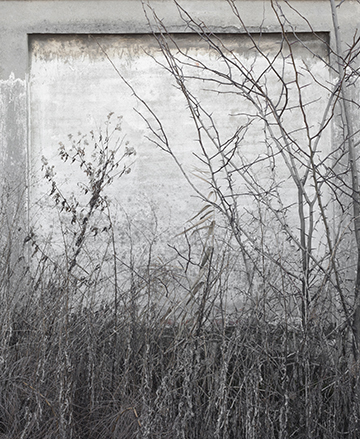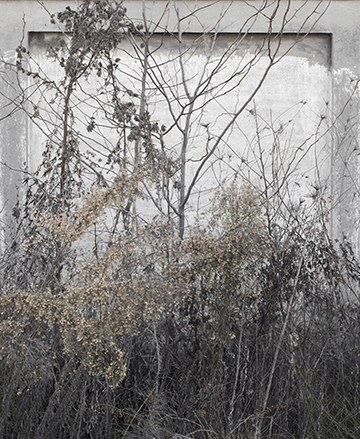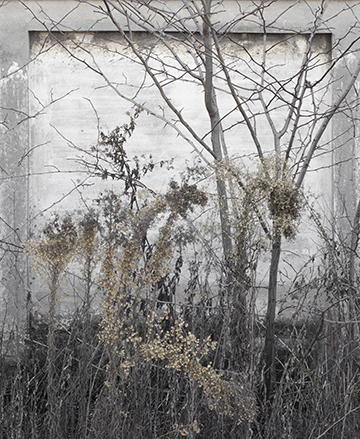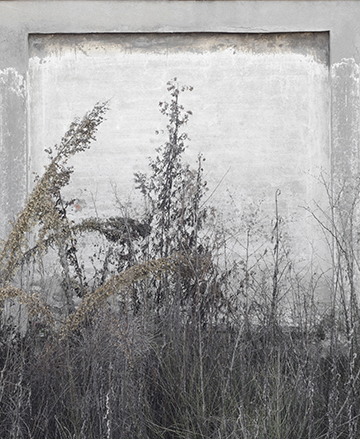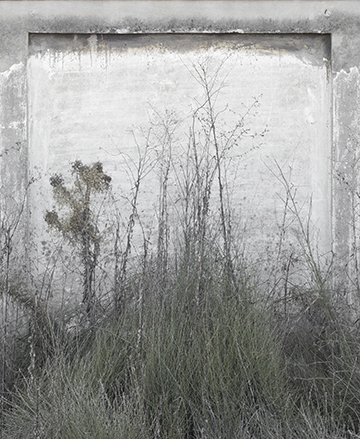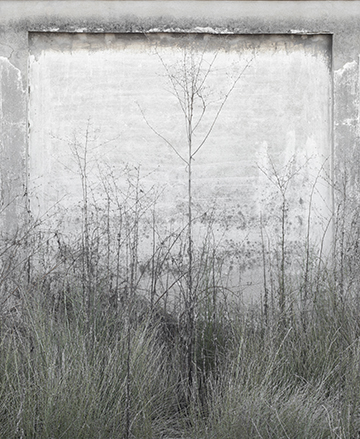WORKS
V Style – Style of Suggestions (2017)
An interesting chapter of ancient art is that of Roman painting, classified by the four Pompeian Styles. These styles have been defined in 1882 by August Mau, who was inspired by Vitruvius (De Architectura) and founded his classification on the wall paintings survived in Pompeii and Hercolaneum after the eruption of Vesuvius in 79 C.E.
In Modena’s craft district, in front of the ruderal plants grown close to the exterior wall provided with projecting cement frames that delimits the area of a factory, suggestion creates a fifth painting style. Even without the impudent luxury of ochres, cinnabar and other ancient pigments, the distinguishing features of this fifth style find correspondences in the four Pompeian ones, but also in some important Eastern iconographic traditions.
Cement Frame #2 –|– Cement Frame #4
The thin plants call to mind more directly the paintings portraying gardens and landscapes survived in Rome and Pompeii, while the luxuriant plants full of erotic charge are reminiscents of Japanese prints. They remind in particular the Japanese overflowing with flowers, waves and cloths, and the indented contours of shrubs and trees on steep slopes. The ancient Persian parádeisos – a fenced palatine garden used for hunting – was full of life too. The Islamic garden derives from it. Even if it is a metaphor of paradise, the Islamic garden is bound up with sensuality and the earthly pleasures. On the miniatures where it is depicted, the abundance of water and the vegetable variety are portrayed with manic precision, that generates harmony and again sensuality.
Series of 8 photographs (31,8 x 26 cm); inkjet print on cotton paper
Cement Frame #3 –|– Cement Frame #5
/ Ita
V Style – Style of Suggestions (2017)
Un capitolo importante dell’arte antica è quello della pittura di ambito romano, distinta nei quattro stili pompeiani codificati nel 1882 da August Mau, che riprese Vitruvio (De Architectura) e si basò sulle pitture parietali sopravvissute a Pompei ed Ercolano all’eruzione del Vesuvio del 79 d.C.
Al Villaggio artigiano di Modena, di fronte alle piante ruderali cresciute a ridosso del muro con cornici aggettanti in cemento che delimita l’area di una fabbrica, la suggestione crea un quinto stile pittorico, i cui elementi caratterizzanti, anche senza il lusso sfacciato delle ocre e del cinabro e degli altri pigmenti antichi, trovano corrispondenze nei quattro stili pompeiani, ma anche in tradizioni iconografiche orientali della medesima importanza.
Cement Frame #14 –|– Cement Frame #13
Le piante rade e sottili rimandano più direttamente alle scene di giardino e paesaggio di Roma e Pompei, mentre le piante più rigogliose, dalla forte carica erotica, ricordano piuttosto le stampe giapponesi: il loro traboccare di fiori, onde e stoffe e le forme articolate di arbusti e alberi sui fianchi scoscesi delle alture. Pieno di vita era anche l’antico parádeisos persiano, un giardino di palazzo recintato utilizzato per la caccia. Da esso deriva il giardino islamico, metafora del paradiso ma non meno legato ai sensi e ai piaceri terreni. Sulle miniature che lo ritraggono, l’abbondanza di acqua e la varietà vegetale sono tradotte in segno e colore con maniacale rigore, artefice di armonia e di nuovo di sensualità.
Serie di 8 fotografie (31,8 x 26 cm); stampa inkjet su carta cotone
